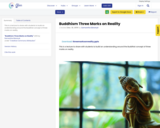
This is a lecture to share with students to build an understanding around the Buddhist concept of three marks on reality.
- Subject:
- History/Social Sciences
- World History
- Material Type:
- Lecture
- Date Added:
- 12/17/2019

This is a lecture to share with students to build an understanding around the Buddhist concept of three marks on reality.

The second of three lessons on Eastern Hemisphere, students learn how physical environment influences human activities. Silk roads connected Europe with China and other areas of East Asia by overland routes. Deserts and mountains posed obstacles for travelers and merchants. Students examine physical maps of the area and determine which routes would best avoid obstacles. They compare the routes they have chosen with the overland and maritime routes of the time period. Key questions: How did physical geography influence the trade routes of the silk roads? Why Europeans traded with China? What are the costs and benefits of cultural interaction?

Art is often about making ideas and beliefs visible. For centuries, religions across the globe have used images to represent complex and abstract ideas about humankind's place in the cosmos. Students can use this interactive exercise to spend thoughtful time with a religious work of art and become curious about the way art can help communicate sacred and profound ideas.